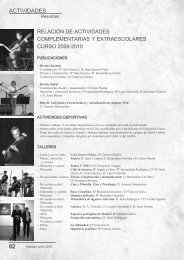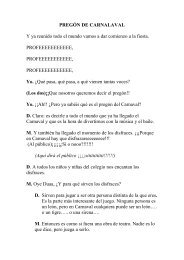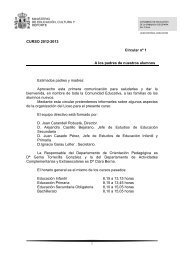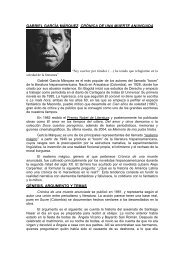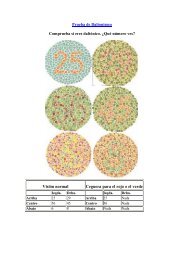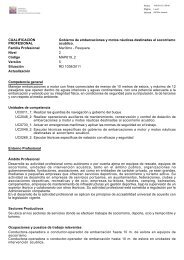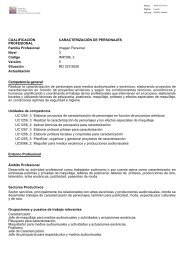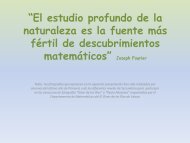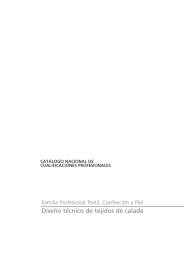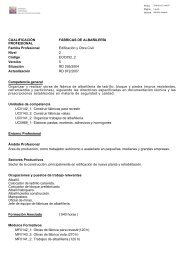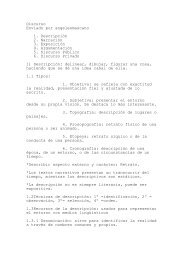- Page 1 and 2:
EMBAJADA DE ESPAÑA EN ESLOVAQUIA A
- Page 3 and 4:
MATERIALES PARA LA PREPARACIÓN DE
- Page 5 and 6:
19. Derivadas 111 Lidia Gómez Agui
- Page 8:
INTRODUCCIÓN Una de las caracterí
- Page 12 and 13:
Tema 1 Lógica proposicional CONCEP
- Page 14 and 15:
• Recíproca: qp , que literalmen
- Page 16 and 17:
Tema 2 Teoría de conjuntos CONCEPT
- Page 18 and 19:
Por tanto, podemos determinar clara
- Page 20 and 21:
Tema 3 Números enteros y racionale
- Page 22 and 23:
Luego debemos hacer cuadrados de lo
- Page 24 and 25:
Tema 4 Potencias y raíces CONCEPTO
- Page 26 and 27: a) La descomposición de 54, en fac
- Page 28 and 29: 1. Averigua si se verifica 3 3 3 =3
- Page 30 and 31: Tema 5 Demostraciones matemáticas
- Page 32 and 33: Si sustituimos la segunda igualdad
- Page 34 and 35: Si efectuamos el producto de los do
- Page 36 and 37: Tema 6 Sucesiones de números reale
- Page 38 and 39: Solución: Sean x, y, z los tres n
- Page 40 and 41: Definición de matrices. Suma y pr
- Page 42 and 43: Solución: Para aplicar el método
- Page 44 and 45: 10. Discute aplicando el teorema de
- Page 46 and 47: Tema 8 Determinantes CONCEPTOS BÁS
- Page 48 and 49: De donde se deduce que si m = 10, e
- Page 50 and 51: Tema 9 Expresiones algebraicas CONC
- Page 52 and 53: Las raíces fraccionarias no entera
- Page 54 and 55: Al ser iguales los grados del resto
- Page 56 and 57: PROBLEMAS PROPUESTOS 1. Descomponer
- Page 58 and 59: Tema 10 Ecuaciones lineales y cuadr
- Page 60 and 61: Resolvemos la ecuación de 2º grad
- Page 62 and 63: PROBLEMAS PROPUESTOS 1. Halla un n
- Page 64 and 65: Tema 11 Sistemas de ecuaciones e in
- Page 66 and 67: 3. Discute, aplicando el teorema de
- Page 68 and 69: 6. Resuelve el siguiente sistema de
- Page 70 and 71: Tema 12 Funciones CONCEPTOS BÁSICO
- Page 72 and 73: Solución: a) La expresión analít
- Page 74 and 75: PROBLEMAS PROPUESTOS 1. En algunos
- Page 78 and 79: 3. Dados los puntos A=(0,1); B = (1
- Page 80 and 81: PROBLEMAS PROPUESTOS 1. En física
- Page 82 and 83: Tema 14 Funciones exponenciales Fu
- Page 84 and 85: ) Lo que debemos hacer aquí es apl
- Page 86 and 87: PROBLEMAS PROPUESTOS 1. Representa
- Page 88 and 89: Tema 15 Razones trigonométricas CO
- Page 90 and 91: 1=sen 2 αsen 2 α→1=2sen 2 α→
- Page 92 and 93: ) Sustituyendo la fórmula del seno
- Page 94 and 95: Resolución de triángulos rectáng
- Page 96 and 97: 4. Halla el lado a del triángulo d
- Page 98 and 99: PROBLEMAS PROPUESTOS 1. En un insta
- Page 100 and 101: Tema 17 Funciones goniométricas F
- Page 102 and 103: Solución: Dominio: Son todos los v
- Page 104 and 105: 2 Luego la función en el intervalo
- Page 106 and 107: Tema 18 Límites y continuidad CONC
- Page 108 and 109: Solución: a) f x lím x∞ gx =
- Page 110 and 111: PROBLEMAS PROPUESTOS 1. Calcula los
- Page 112 and 113: Tema 19 Derivadas CONCEPTOS BÁSICO
- Page 114 and 115: i) f x=sen x 2 5x−1 j) f x=5e x2
- Page 116 and 117: PROBLEMAS PROPUESTOS 1. Encuentra e
- Page 118 and 119: Tema 20 Análisis de funciones: rep
- Page 120 and 121: • Asíntotas. Horizontal lim x
- Page 122 and 123: Vertical: lim x0 f x=lim x 0 x =∞
- Page 124 and 125: Tema 21 Integral indefinida CONCEPT
- Page 126 and 127:
Asignado valores a x obtenemos: Si
- Page 128 and 129:
PROBLEMAS PROPUESTOS 1. Encuentra l
- Page 130 and 131:
Tema 22 Integral Definida CONCEPTOS
- Page 132 and 133:
Pero como las funciones son simétr
- Page 134 and 135:
Tema 23 Geometría métrica en el p
- Page 136 and 137:
c) El arcCA está limitado por los
- Page 138 and 139:
5. Calcula los ángulos internos, l
- Page 140 and 141:
Tema 24 Geometría métrica en el e
- Page 142 and 143:
Ese ángulo es precisamente el án
- Page 144 and 145:
PROBLEMAS PROPUESTOS 1. Una pirámi
- Page 146 and 147:
Tema 25 Transformaciones geométric
- Page 148 and 149:
Solución: Una simetría respecto a
- Page 150 and 151:
PROBLEMAS PROPUESTOS 1. Dado el sig
- Page 152 and 153:
Tema 26 Vectores en el plano y en e
- Page 154 and 155:
3. Calcular el valor de a y b para
- Page 156 and 157:
Tema 27 Geometría analítica en el
- Page 158 and 159:
3. Halla el punto de corte de la re
- Page 160 and 161:
PROBLEMAS PROPUESTOS 1. Escribe, de
- Page 162 and 163:
Tema 28 Geometría analítica en el
- Page 164 and 165:
Es decir, las ecuaciones paramétri
- Page 166 and 167:
Tema 29 Problemas métricos en el p
- Page 168 and 169:
4. Calcula el área del triángulo
- Page 170 and 171:
Concepto de lugar geométrico. La
- Page 172 and 173:
Observamos que el semieje mayor de
- Page 174 and 175:
PROBLEMAS PROPUESTOS 1. Encuentra l
- Page 176 and 177:
Tema 31 Combinatoria CONCEPTOS BÁS
- Page 178 and 179:
4. ¿Cuántas palabras de 5 letras
- Page 180 and 181:
Tema 32 Probabilidad CONCEPTOS BÁS
- Page 182 and 183:
A B 10% 18% 28% B 25% 47% 72% A 35%
- Page 184 and 185:
PROBLEMAS PROPUESTOS 1. Se seleccio
- Page 186 and 187:
Tema 33 Estadística CONCEPTOS BÁS
- Page 188 and 189:
moda, M o , y la mediana, M e . Las
- Page 190 and 191:
En este ejemplo, el rango de los va
- Page 192 and 193:
Así x= 269 5 =53,8, y= 1699 5 =139
- Page 194 and 195:
Tema 34 Números Complejos CONCEPTO
- Page 196 and 197:
4. Resuelve en ℂ las siguientes e
- Page 198 and 199:
BIBLIOGRAFÍA Libros • Barreiro-R



